Back in January, when this fine season was merely a twinkle in our collective eye, Travis Sherer took a look at Andrew Benintendi and pointed out what a big year this was for the Red Sox-turned-Royal. How Benintendi got here is interesting, and you should go read Travis’s piece for more on that. But the big question was whether or not Benintendi could get himself back on track to stardom.
Because if we rewind to August 2019, he was on the track to stardom. On August 16, 2019, Benintendi went 3-for-4, coming up a home run short of the cycle, and raised his career wRC+ to 114. He was less than a year removed from being a key cog on a World Series champion, having put up a 4.4 fWAR season in 2018. And then the wheels fell off.
On August 17th, he went 0-for-4. Then he went 0-for-5, then he went 0-for-4 again. And while things improved from 0-for-13, they didn’t improve a lot. From August 17, 2019 through the end of the shortened 2020 season, Benintendi’s wRC+ was 30. I want to be clear, that is not a typo. It was not 130. I didn’t hit 3 instead of 6 on a number pad trying to type 60 (which would still be awful). For 161 PA, Benintendi simply stopped being able to hit major league pitching.
But after play on Thursday, May 6, 2021, Benintendi is sitting pretty with a 121 wRC+ on the young season – right in line with his 121 as a rookie, 123 in 2018, and 117 in the first 75% of 2019. So at first glance, it appears the answer is yes – Beni is back. But how and why he is back will help inform whether he is back to stay.
Contact is Back
One of the best ways to figure out what might be driving a turnaround is to figure out what might have driven the collapse in the first place, and this chart feels very telling.
While both Benintendi’s wOBA and his contact rates have bounced around, there is a very clear drop in both starting late in 2019 and continuing through 2020. What happens when you make less contact? You strike out more:
You’ll never see a perfectly flat line for either of those rates, but Benintendi was pretty steady most of his career, up until late 2019. Then his contact rate started to fall while his strikeout rate started to climb, with the former bottoming out and the latter spiking in 2020. But as we move into the middle of 2021, those lines are moving away from each other in the best way possible. That rolling contact rate is over 90% for just the third time in his career; the rolling strikeout rate is nearing a career-best, as well.
Hard Hits are Increasing
While his contact rates fell, he never had a big issue with hard hits. Benintendi has never been among the very best when it comes to exit velocity, but even in his downturn, he wasn’t bad.
His hard-hit rate increased slowly but surely early in his career, and spiked in early August 2019 – right around that pivot point in his performance that we noted in the introduction – before falling off. But even during his rough finish to 2019 and brief, brutal 2020, it never dropped that far. He had worse periods throughout his career. The problem for Benintendi is that hard-hit rate is measured per batted ball event and because of his dropping contact rate, a steady rate of hard hits per batted ball is going to represent a drop in hard hits per plate appearance or per swing, both of which are more telling.
The exciting thing on this graph is the current trend. At the same time his contact rate has been increasing, his hard-hit rate is heading up. As of Thursday, his rolling hard-hit rate was at 48%, tied for the second-highest peak of his career. You want to know what will usually lead to good results? If you can maximize your hard-hit rate and your contact rate at the same time, and Benintendi is doing just that.
Of course, hard-hit rates are up league-wide:
| Year | MLB Hard-Hit Rate | MLB Barrel Rate | MLB Average EV |
| 2019 | 36.3% | 6.8% | 88.7 mph |
| 2020 | 37.4% | 7.6% | 88.4 mph |
| 2021 | 39.5% | 8.3% | 89.0 mph |
So yes, Benintendi is hitting the ball hard more often, but does that represent real improvement or just a nice boost from the new ball? He didn’t play enough in 2020 to compare him to other hitters, but in 2018 and 2019, his average exit velocities were in the 44th and 46th percentile. In 2021, he is in the 60th percentile. In 2018 and 2019, his hard-hit rates were in the 31st and 41st percentiles. In 2021, he is in the 55th percentile.
It’s not all good news – his 2019 barrel rate was above average (8.1%) and this year it is below average (7.2%). His max exit velocity this year is just 105.4 MPH, which is 35th percentile. In 2019, he was in the 55th percentile with a 107.7 MPH max EV. But keep in mind we are dealing with small sample sizes, particularly on something like barrels. He has six barrels; if he had seven, his barrel rate would be 8.4% which would be back above average.
There isn’t enough signal here to say that Benintendi is hitting the ball harder or hitting it hard more often, but it certainly appears he is at least maintaining his contact quality while making more contact, and that is a great sign.
Back to Pulling the Ball
Old school baseball thinking has always praised guys who can go the other way or use the middle of the field, and there is some value to being able to hit to all fields. But there’s another pattern in Benintendi’s career that suggests that he might have taken that too far.
There is a lot going on there, but pay attention to which color you see poking up over the top the most – from 2016-early 2019, the peaks are mostly blue (pull percent), though he occasionally had periods of going up the middle more. Starting in 2019, and getting most extreme in late 2019 through 2020, he went up the middle more, and pulled the ball less. In 2021, he is again pulling the ball more. Not a ton more – in fact, 2021 seems to be about as “all-fields” as he has been in his career, as all three lines converged early in the season. But that pull rate is increasing and the graph is starting to look more like his best years.
Closing Up
What’s behind this improvement? According to Benintendi, it’s a change in his stance. He says he closed his stance, allowing him to see the ball better and longer, and helping him avoid “peeling out and rolling over” pitches. And it certainly seems that is the case. Here is Benintendi hitting into a hard out early this year:
And here he is going deep more recently:
Yeah, that definitely looks like a more closed stance. Is that a return to a stance that served him better earlier in his career? Well, yes and no.
Here he is in 2018, in the midst of his best year, using an open stance and driving a double off the Green Monster.
And here he is in September 2019, in the midst of his 161 PA swoon, with a closed stance, hitting a ball to the deepest part of Fenway.
He seems to have had success with both an open and a closed stance. Maybe it depends what he needs at any given time? Maybe the simple act of making a change helped him solve a specific problem? I am not sure, to be honest. What I do know is he felt he needed a change, he made a deliberate change, and he has found success with that change.
But check out this GIF – the first image, with the open stance is April 20. The second image with the closed stance is April 21. 
Seems pretty clear right? One day the front foot is set back towards the dugout compared to the back foot. The next day, they are much closer to lined up. Lest you think this was an overnight process, let’s look at that again, with a third image, from April 13:
Back on April 13, his front foot was completely clear of his back foot. But over that next week, he made adjustments. As of April 20, before the stance moved to “fully closed,” he had a wRC+ of 50, a 27.0% strikeout rate, and a 32.5% hard-hit rate. Since April 21, his wRC+ is 204, his strikeout rate is 9.4%, and his hard-hit rate is 51.2%. We’re now comparing 63 “before” plate appearances to 53 “after” plate appearances, so none of this is definitive or guaranteed to stick. But it sure is interesting.
What’s Coming Next
So did Benintendi just get hot for 50+ plate appearances over a couple of weeks? Or has he put his career back on track? The short answer is that it is too early to tell. We need to see if these improvements stick over a longer period.
But if I am going to bet on a breakout – or a return to form – I am going to do it when there is an explanation. Add in Benintendi’s pedigree and previous performance, and I think there is good reason to buy into this.
In fantasy leagues, there is a big first-mover advantage. If you wait until you are sure Benintendi is going to be a star before you buy in, someone else will beat you to it. I am worried I might already be late, as Benintendi was drafted or recently added in most of my leagues. Where he is still a free agent, or where he can be had in a trade, I am making room for him on my rosters.
Photo by Scott Winters/Icon Sportswire | Feature Image by Justin Redler (@reldernitsuj on Twitter)

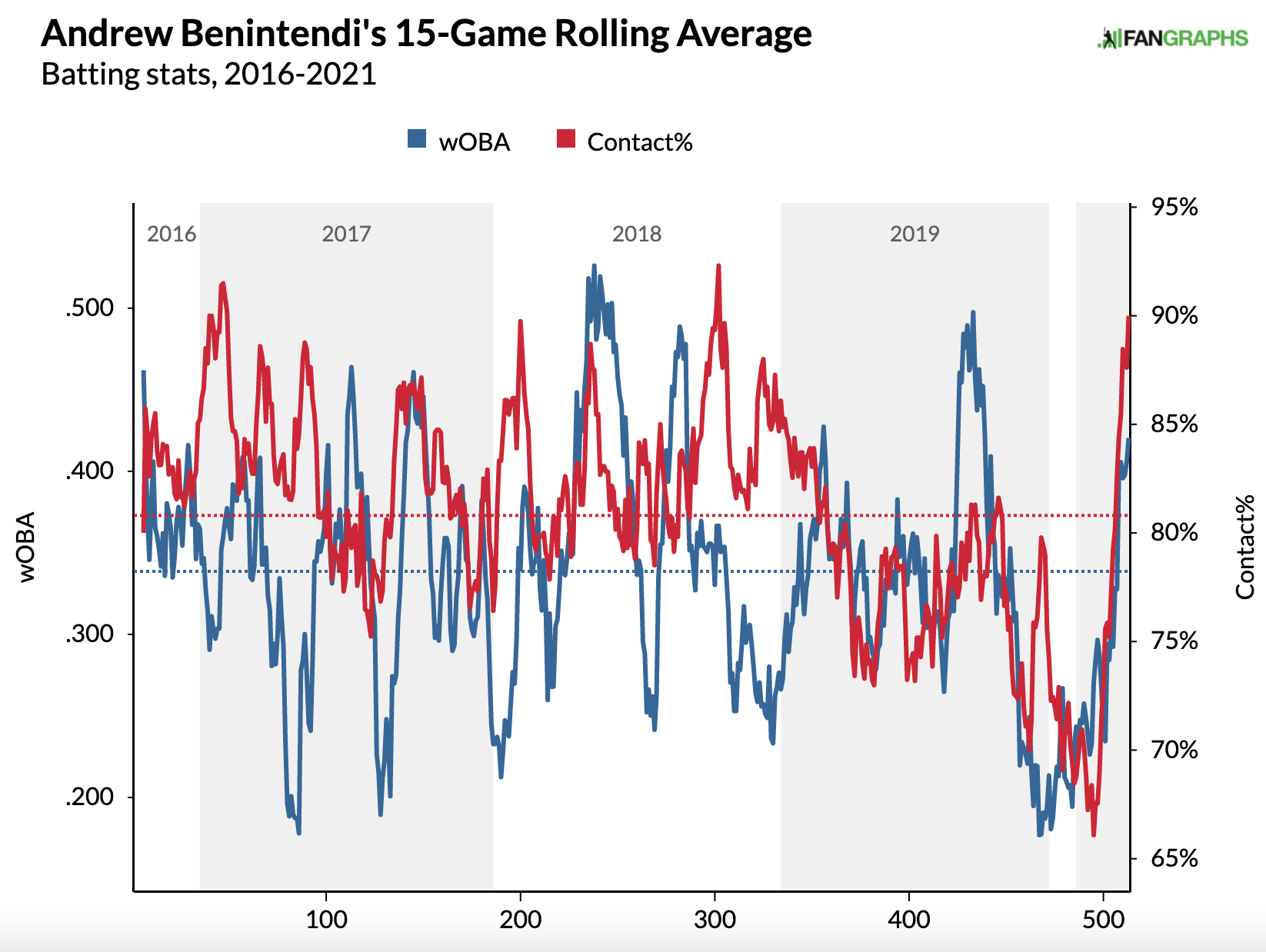
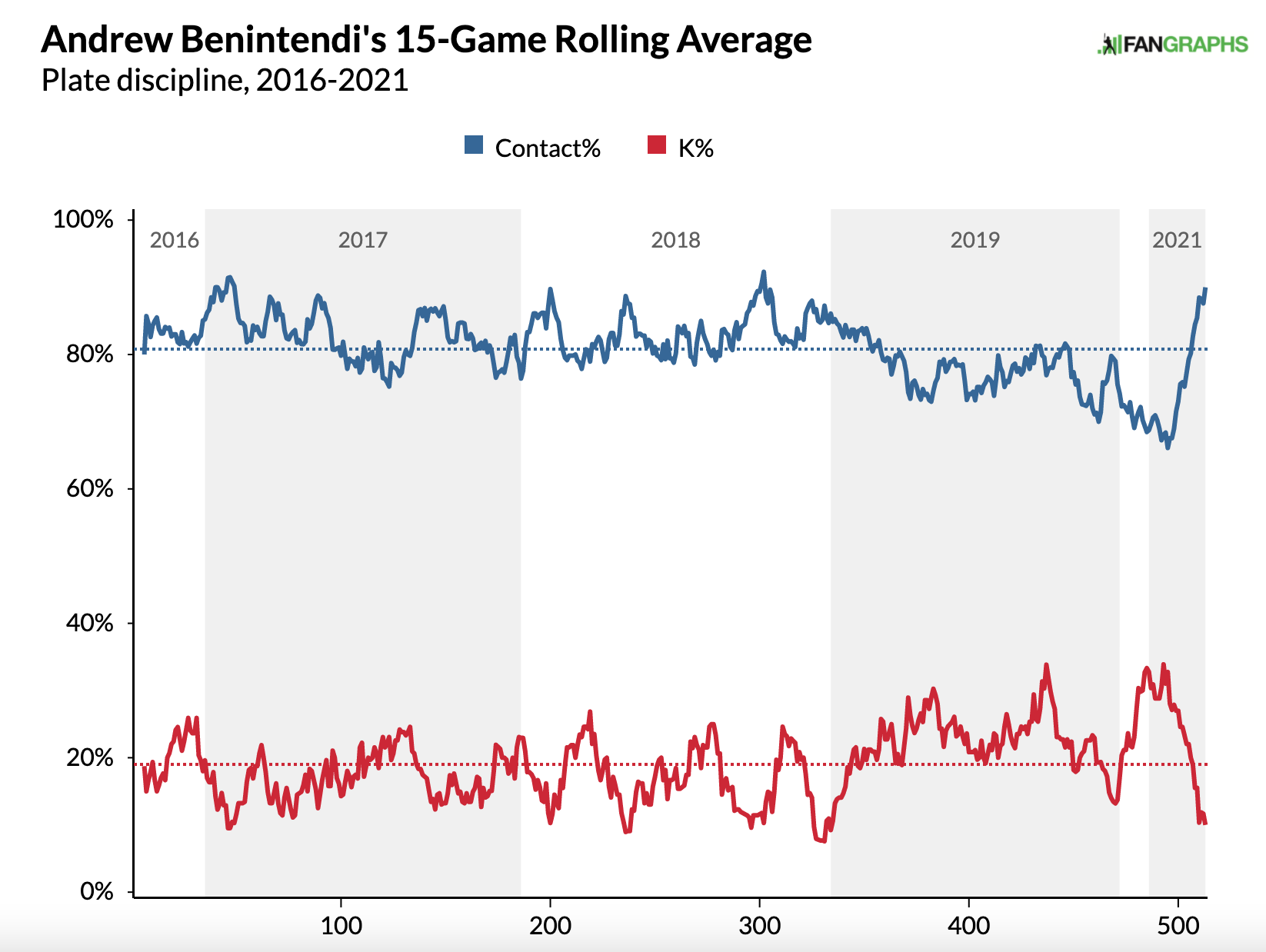
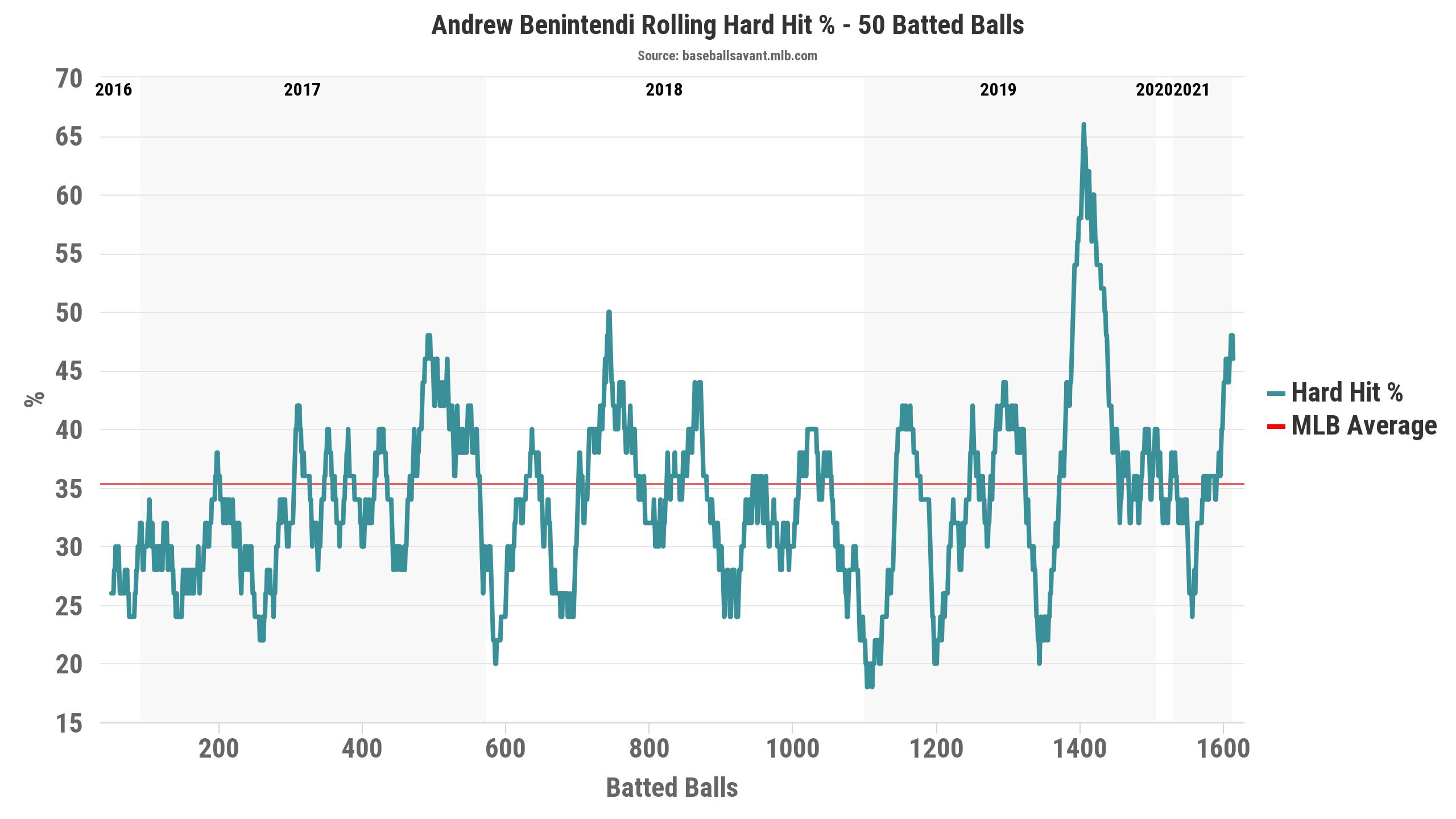
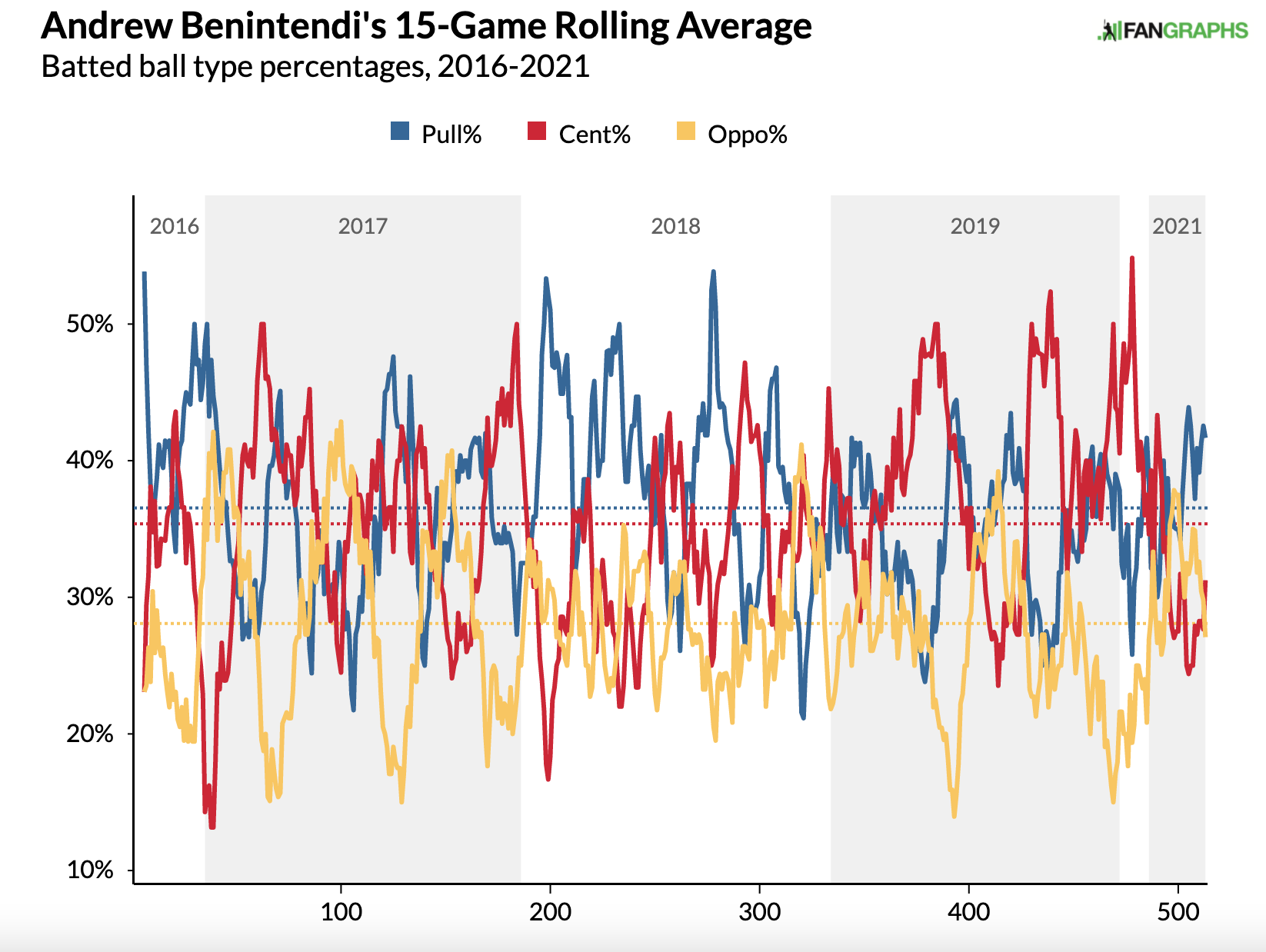
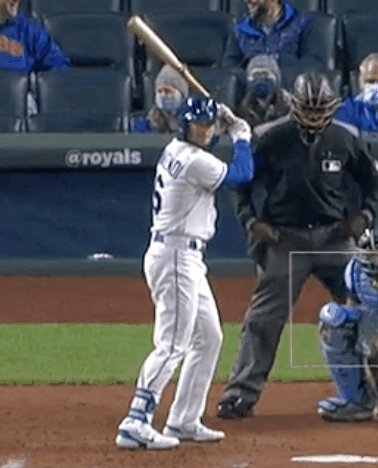
Nice to see Super Benintendo Chalmers come back. He was done dirty by the Boston FO.
To be clear, old-school is what professionals learned over a century and it was supported by data. They were right about literally everything. New school = wrong. Granted, it doesn’t have to be that way but it currently is. The best new school analysis jives with old school analysis. Most new school analysis is a childish attempt to recreate what people have known for decades. The other chunk is just totally off base and regressive. There was an entire “revolution” fueled by juiced balls, which was pawned off as progress, but it was really just a commercial for cloud storage. As more people flood into the new school analysis, that should create better understanding right? The on-field baseball is much worse – completely subjective I admit, but MLB is infuriating to watch. One of the best ways to understand the regressive baseball culture is that many people are only interested in irrelevant outcomes and highlights… these folks certainly do not understand the basics of the game otherwise they would be watching the game, not the outcomes. What has gotten completely lost is the ability to see what good and bad baseball looks like, which has always been the most important. I have no doubt that if a team were free to run an organization in an old school manner then they would be very successful… but hopping on the progressive train, spending the minimum and cashing checks is MLB baseball. Promote those players as young as you can and pass that off as progressive while you are at it. If everything gets worse together, then nobody will notice – that is where we are at on the curve. Never mind the developmental shortcomings… again, winning and quality baseball is not the goal – its about saving money and everything other than on-field baseball.
After all of that BS, Ill give you some old school analysis. Pre-swing observations are very close to meaningless. What actually matters is where he strides to and I am not sure if he is any more closed or open after the stride. You can stand there holding the bat like Julio Franco – it doesn’t really matter – it only matters where the bat is when you swing. While you can cause yourself problems with open/closed or other pre-swing things , its not likely very important. More accurately it is just about comfort – its more like superstition than significant mechanically. When you see major pre-swing adjustments, I would bet that they coincide with struggles as the player is trying anything to get back on track. It appears to me that Beni was never that good of a hitter. I am not a historian here, but I imagine that his only really valuable season was one where he had serious lineup protection (yes, I know that this doesn’t exist as per a FG blog). He was more in a great lineup in a prestigious organization. There is one reason to own him and that is for SB. If he isn’t providing those, then he seems pretty pedestrian to me. It is worth remembering that he was a polished college bat and he doesn’t have a ton of physical upside. I suspect that if his name meant nothing, then we wouldn’t be giving him any attention. I appreciate the player choice though – it is sifting through the mediocrity where you find value. I don’t have much insight on this one, but I could see him going downhill. He might not be far away from realizing that his best is well behind him. I do hope that you are right and that he takes some steps forward – the game needs good players as it is very short on them.
And… his little 5-game hot streak appears to be over. I don’t think he’ll live up to what we initially thought/hoped. The strength isn’t there, everything is slapped the other way, but the green monster isn’t there to help anymore. We thought he had good contact and plate discipline, but he’s settled in as a 20%K rate, which just is just too high for a slap hitter.